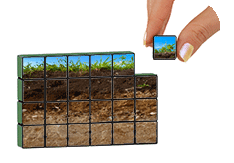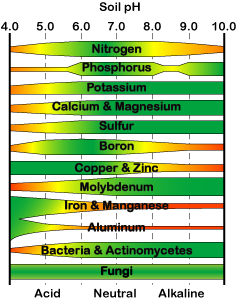|
| This mailer has been provided as an avenue of dispersing information related to landscape architecture in hopes of fostering greater understanding and collaboration between professions. Topics address issues that affect the built environment within which we live. |
|
Building Blocks of the Outdoor Environment Series: Soils
Author: Chad Kennedy, Landscape Architect, ASLA
General Make-up of Soils In general the creation of soils begins with erosive forces breaking down elemental rock bodies into smaller and smaller pieces which are then deposited elsewhere. The deposits are joined with liquids and gases that make up a soil solution. Eventually plant matter, other organic materials and living organisms are introduced. This biotic mixture of decomposed base rock, soil solutions, organic materials and living organisms, is referred to as "soil".
Fertility - Soil fertility is directly related to the amount of macro and micro nutrients available in the soil. Macronutrients are needed in large amounts and consist of nine elements: Carbon, Hydrogen, Oxygen, Nitrogen, Phosphorus, Potassium, Calcium, Magnesium and Sulfur. Micronutrients are needed in very small amounts and consist of Iron, Manganese, Boron, Zinc, Copper, Chlorine, Cobalt, Molybdenum and Nickel. Each of these nutrients play vital roles in the growth and metabolic processes of plants. Even slight deficiencies in micro-nutrients can cause discoloration of leaves, spotted leaves, stunted growth and may even lead to serious plant health issues.
Cation exchange capacity - Soils retain high levels of nutrients needed to sustain plant life. Most of them are unavailable to plants, however, because plant roots cannot absorb soil minerals directly. An exchange process must occur between the plant and the soil via a soil solution. The ability for the soil to exchange its nutrients, or make them available to the plant, is called its "cation exchange capacity" (CEC). Organic materials and soils with high CEC are better for plant growth as they can consistently supply sufficient nutrients to support plant metabolic functions. Soils with low CEC may have sufficient nutrient levels to support plant life, but they remain in an unavailable form. The cation exchange capacity of a soil is closely tied to soil texture as described below.
Organic Materials - Organic materials in the soil often referred to as humus (hyü-məs) greatly influence the functionality (for planting purposes) of soils. The dark or black color of many soils are due to high levels of organic materials which are very effective at exchanging nutrients, retaining moisture, improving soil textures, breaking down soil minerals, supporting microbial activity, buffering pH levels and providing a natural method for slow-release of nutrients. In most cases organic materials are the single most effective soil conditioner and will improve plant growth.
Texture - Soil is comprised of mineral particles varying greatly in size and material. The proportions of varied sized particles in the soil is referred to as soil texture. The three main categories of particles are: sand, silt and clay.
Sand particles are between 2.0mm and 0.05 mm in diameter and feel gritty when rubbed between your fingers. These particles have relatively low surface area resulting in less holding capacity for nutrients and water. Silt particles are between 0.05 mm and 0.002mm in diameter, and feel smooth or silky when rubbed between your fingers. These particles are much smaller than sand and therefore have far more surface area to hold nutrients and water. Clay particles are smaller than .002 mm in diameter and when rubbed between fingers feels plastic and moldable. These particles have very large relative surface areas. In fact one spoonful of clay may have a surface area equivalent to that of a football field. 1
Desirable soils have a balanced mix of soil particles consisting of large sand particles, (that assist in movement of nutrients, air and water through the soil) silt particles, which store and release nutrients and water, and clay particles, (needed in small amounts) which retain nutrients and water, and buffer soils from changes in soil temperature, pH and from leaching. See this soil chart by the USDA for more information on soil textures.
Though seemingly simple, soil is a complex combination of natural ingredients, together acting as one of the most important building blocks in our outdoor environments. For more information related to soils and appropriate plantings for your type of soil, please contact us at the number below.
1. Brady, Nyle C. and Ray R. Weil. Elements of the Nature and Properties of Soils. Prentice Hall Inc. Upper Saddle River, New Jersey. 2000. |
|
|
|
|
|
|
|
|
|
|
|
|
|
|
|
|
|
|
|
|
|
|
 Many years ago I was sitting in a dimly lit basement classroom listening to a beginning level college soil science lecture. The well-seasoned, and a bit eccentric, professor was describing, with a stern tone, the general properties of soils. He was drilling one single concept into the student's eager minds; "There is no such thing as dirt!" His purpose in this was to instill in young horticultural oriented minds that soils are complex, contrary to the simplicity implied by the word "dirt". Any thorough review of soils will expose a heterogeneous combination of many organic, mineral and elemental components. The results of these combinations are physical properties that determine levels at which plant life can thrive. A few of these properties are pH levels, fertility, exchange capacities and textures.
Many years ago I was sitting in a dimly lit basement classroom listening to a beginning level college soil science lecture. The well-seasoned, and a bit eccentric, professor was describing, with a stern tone, the general properties of soils. He was drilling one single concept into the student's eager minds; "There is no such thing as dirt!" His purpose in this was to instill in young horticultural oriented minds that soils are complex, contrary to the simplicity implied by the word "dirt". Any thorough review of soils will expose a heterogeneous combination of many organic, mineral and elemental components. The results of these combinations are physical properties that determine levels at which plant life can thrive. A few of these properties are pH levels, fertility, exchange capacities and textures.  Physical Properties of Soils
Soil pH -pH is the measurement of soil acidity or alkalinity. Plant species tolerance for pH levels can vary considerably, however the effect of pH on overall nutrient availability is perhaps the most important information to understand. The figure to the right depicts the effect on nutrient availability and microorganism activity at various pH levels. As is illustrated, extremes at either end of the pH spectrum greatly limit nutrients and microorganisms. Most plants are well suited to pH levels ranging between 5.5 and 7.0. As soils vary greatly from project to project, it is advised that each project have at least one soil sample obtained and tested for landscape suitability. Lab results will describe existing soil conditions as well as offer suggestions for soil amendments to improve soil conditions for optimal plant growth.
Physical Properties of Soils
Soil pH -pH is the measurement of soil acidity or alkalinity. Plant species tolerance for pH levels can vary considerably, however the effect of pH on overall nutrient availability is perhaps the most important information to understand. The figure to the right depicts the effect on nutrient availability and microorganism activity at various pH levels. As is illustrated, extremes at either end of the pH spectrum greatly limit nutrients and microorganisms. Most plants are well suited to pH levels ranging between 5.5 and 7.0. As soils vary greatly from project to project, it is advised that each project have at least one soil sample obtained and tested for landscape suitability. Lab results will describe existing soil conditions as well as offer suggestions for soil amendments to improve soil conditions for optimal plant growth. 
